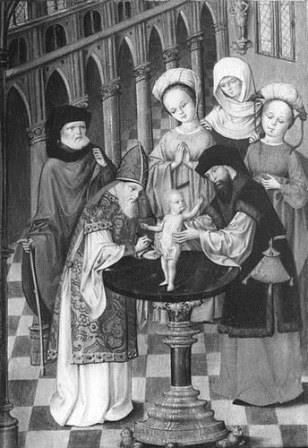In a letter dated 2 May 2006, the State Secretary asked the Committee to issue a recommendation regarding a decision to be taken on the application filed on 9 April 2006 for the restitution of the painting The Circumcision by an anonymous artist of Westphalia, dating from the last quarter of the 15th century (NK 1614). The painting was on loan to the Bonnefanten Museum in Maastricht. The work was previously attributed to the Master of Kappenburg, also known as the Master of Kappenberg or Cappenberg, or as Jan Baegert.
The painting appeared to have been the property of the applicants’ grandmother, Johanna Margaretha Stern-Lippmann, of Jewish origin. She was born in Berlin in 1874, where she lived with her husband and four children until 1935. After the death of her husband, she fled to the Netherlands. She made several attempts at procuring an exit visa for herself and several members of her family during the first years of the occupation. To this end, she handed over a painting by the artist Fantin Latour to the Dienststelle Mühlmann. No exit visas were issued, however, and the painting was taken to Austria. The Latour was not returned to the family until 1949. After the war, an authorised agent wrote of the fate of Stern-Lippmann:
‘With no exit visa being issued, Mrs Stern was forced, at the age of 70, to go into hiding. She suffered considerably. Her household effects were confiscated and disappeared, and she lost most of her remaining belongings as well. In the end she was arrested and deported to Auschwitz, where she perished.’
Her daughter Louise Henriette and son-in-law also died in Auschwitz in 1944; the remaining three Stern-Lippmann children survived the war.
The investigation confirmed that the Stern-Lippmann family had lost the greater part of their art collection. For instance, a letter from an authorised agent of the family dated 1955 was found in the archives asking the Dutch authorities if anything was known about 28 paintings and works of art, which had belonged to the family in 1940 and which had not been found in the estate after the war. In addition to works by well-known Impressionists such as Renoir, Pisarro and Degas, and other masters, the list also referred to a work as ‘Tappenberg, Circumcision’. The Committee found it plausible that this was the claimed work and that this must have been a writing error.
The Committee was therefore of the opinion that this painting could be assumed to have belonged to Stern-Lippmann in 1940. Further investigation of the claimed work confirmed that the painting had, in any case, been in Stern-Lippmann’s possession before 1941. This could be concluded from various documents in the archives of Amsterdam art dealer P. de Boer, including an inventory card, a photograph and a reproduction of the claimed work. The words coll. Stern were noted both on the back of the card and on the photograph, although no date was given. As the said records showed, the work came into someone else’s possession in 1941 and it was purchased by art dealer P. de Boer in January 1942. The painting was subsequently sold to a German museum.
In its meeting of 18 December 2006, the Committee recommended that the painting be returned to Stern-Lippmann’s heirs. The Committee considered it sufficiently plausible that the claimed work was owned by Stern-Lippmann in 1940 and that she lost possession of it after 10 May 1940. The Committee considered that the loss of possession should be deemed as having been involuntary, a result of circumstances directly associated with the Nazi regime.
In a decision taken on 17 January 2007, the Minister decided to return the painting to the heirs.
